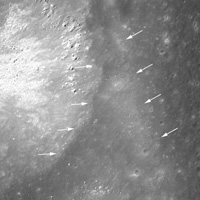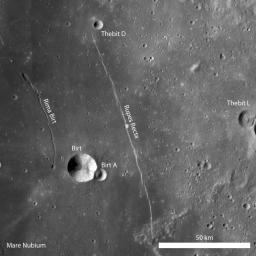Rupes Recta
Caption:
Rupes Recta is a well-known linear rille that extends over 100 kilometers in length. Portion of LROC WAC monochrome mosaic, illumination is from the left, and asterisk notes location of LROC NAC.

|
|
Click on image for larger version
|
|
|
Cross-cutting relations between Rupes Recta and an impact crater are evident in this subset of LROC NAC image M12264663R. The cliff-face of Rupes Recta is noted by the arrows on the right side of the image. At some point after the formation of Rupes Recta, an impact occurred and excavated material from the fault wall. The arrows on the left side of the image (forming a somewhat-curvilinear path) denote the crater wall. Subsequent down-slope movement of eroded debris and blocks is visible. Image width is 840 meters, illumination from the left, and the low-incidence angle of this image highlights the albedo variations
|
|
Several weeks ago LROC featured a series of WAC monochrome mosaics of some of the most spectacular sinuous rilles on the Moon (Rimae Posidonius, Vallis Schörteri, and Rimae Prinz). Unlike sinuous rilles, linear rilles (or graben) are not believed to primarily result from lunar volcanism. Linear rilles are surface manifestations of structural faulting that formed when the lunar crust was pulled apart. The widths of these linear rilles range from as little as a few meters to kilometers across; Rupes Recta is between 1-3 kilometers wide across its length. In addition, Rupes Recta is composed of several en echelon segments - the linear rille is not a single, uninterrupted 100 kilometers length fault. There are at least 5 large fault segments visible at the LROC WAC scale (100 meters/pixel) that range from ~8 kilometers to 50 kilometers in length.
Background Info:
NASA's Goddard Space Flight Center built and manages the mission for the Exploration Systems Mission Directorate at NASA Headquarters in Washington. The Lunar Reconnaissance Orbiter Camera was designed to acquire data for landing site certification and to conduct polar illumination studies and global mapping. Operated by Arizona State University, LROC consists of a pair of narrow-angle cameras (NAC) and a single wide-angle camera (WAC). The mission is expected to return over 70 terabytes of image data.
Cataloging Keywords:
| Name |
Value |
Additional Values |
| Target |
Moon |
|
| System |
Earth |
|
| Target Type |
Satellite |
|
| Mission |
Lunar Reconnaissance Orbiter (LRO) |
|
| Instrument Host |
Lunar Reconnaissance Orbiter |
|
| Host Type |
Orbiter |
|
| Instrument |
Lunar Reconnaissance Orbiter Camera (NAC) |
|
| Detector |
|
Narrow Angle Camera (NAC), Wide Angle Camera (WAC) |
| Extra Keywords |
Crater, Grayscale, Impact, Volcano |
| Acquisition Date |
|
| Release Date |
2011-02-10 |
| Date in Caption |
|
|
| Image Credit |
NASA/GSFC/Arizona State University |
| Source |
photojournal.jpl.nasa.gov/catalog/PIA14005 |
| Identifier |
PIA14005 |


